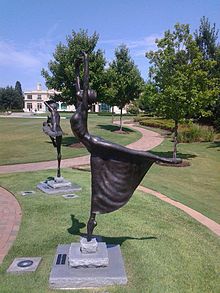Rosella Hightower
Rosella Hightower (born January 10, 1920 in Durwood , Oklahoma , † November 4, 2008 in Cannes , France ) was an American ballet dancer who was known both in the United States and in Europe.
origin
Rosella Hightower was born in Durwood, Oklahoma near Ardmore . She was the only child of Charles Edgar Hightower and his wife Eula May Flanning. Her father was a member of the Choctaw tribe . When he took a new job with the Missouri-Kansas-Texas Railroad Company, the family moved to Kansas City . Here Rosella began her training as a dancer with Dorothy Perkins.
Europe
When the Russian choreographer and dancer Léonide Massine was performing in Kansas City in 1937 , he invited Hightower to join his new ballet company in Monte Carlo . When Hightower flew there at her own expense, she found that she should only attend one more audition at first . But then she was accepted into the company and met her future dance partner André Eglevsky . After the outbreak of the Second World War , Hightower returned to New York and accepted an engagement at the American Ballet Theater .
In 1946 she switched to Colonel Wassily de Basil's ballet, which performed under the name Original Ballet Russe . After a performance of Giselle in March 1947 at the Metropolitan Opera , she was acclaimed by the critic John Martin. Originally Alicia Markova provided for the lead role. However, she fell ill and Hightower had to rehearse the role in just five hours. Martin then wrote: "The Original Ballet Russe had no news planned for the opening night ... nonetheless, there was bigger news on the program: It was the unannounced first appearance of Rosella Hightower in the title role of Giselle." He called her appearance "a thorough one." admirable performance, which earned her ovations from the audience. "
Three days later, Martin wrote in his review of Swan Lake : "The newest star in the ballet sky".
In the same year, she accepted an invitation from the Marquis George de Cuevas to become a member of his new company Grand Ballet du Marquis de Cuevas (Cuevas Ballet for short). One of the deciding factors for her change was the collaboration with the choreographer Bronislava Nijinska in the new company. Nijinska designed the ballet Rondo Capriccioso for Hightower . In another piece, Piège de Lumière by John Taras , Hightower danced a butterfly in a tropical forest that enchants a group of escaped prisoners.
When Cuevas died in 1961, the troupe disbanded and Hightower, now over 40 years old, gradually withdrew from the stage. In 1962 she appeared several times, including with Erik Bruhn and Rudolf Nurejew and opened the Center de Danse Classique ballet school in Cannes.
In the 1970s and 1980s she headed several ballet companies: the Marseilles Ballet from 1969 to 1972, the Ballet des Grand Théâtre in Nancy from 1973 to 1974, the Paris Opera Ballet from 1980 to 1983 and the La Scala Ballet in Milan from 1985 until 1986.
Rosella Hightower was found dead at her home in Cannes on November 4, 2008. It is believed that she died of a stroke early that morning or the night before.
Hightower had been married to Jean Robier , a French artist and designer, since 1952 . They had a daughter, Dominique (* 1955).
Honor
Along with four other Native American dancers ( Yvonne Chouteau , Moscelyne Larkin , Maria Tallchief and Marjorie Tallchief ), Hightower was honored with a statue called The Five Moons . The statue is located in the garden of the Tulsa Historical Society ( Tulsa , Oklahoma).
Web links
- Rosella Hightower in the Internet Movie Database (English)
- The Ballerina Gallery - Rosella Hightower
- Sunday NY Times, John Martin, October 29, 1939
- NY Times, November 18, 1939
- NY Times, John Martin, March 24, 1947
- NY Times, John Martin, April 25, 1956
- LA Times, Nov. 9, 2008, obituary by Nora Boustany
- NY Times November 4, 2008, obituary by Jack Anderson,
Individual evidence
- ^ Short, Candy Franklin. Hightower, Rosella (1920-). Oklahoma Historical Society's Encyclopedia of Oklahoma History & Culture. 2009
- ↑ a b c d e f g The New York Times of November 4, 2008: "Rosella Hightower, Prima Ballerina and School Founder, Is Dead at 88"
- ↑ Martin, John. Rosella Hightower scores in Giselle Role ... The New York Times March 21, 1947
- ↑ Martin, John. The New York Times of March 24, 1947: "The Ballet Russe at Metropolitan; Rosella Hightower Seen Twice in 'Swan Lake" ... "
| personal data | |
|---|---|
| SURNAME | Hightower, Rosella |
| BRIEF DESCRIPTION | American ballet dancer |
| DATE OF BIRTH | January 10, 1920 |
| PLACE OF BIRTH | Durwood , USA |
| DATE OF DEATH | November 4, 2008 |
| Place of death | Cannes , France |


